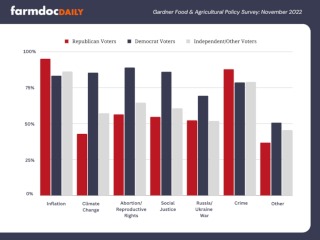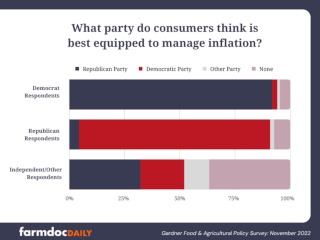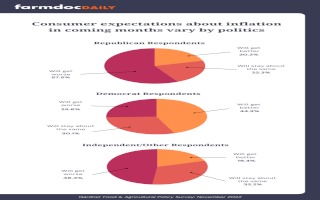By Maria Kalaitzandonakes and Jonathan Coppess
Department of Agricultural and Consumer Economics
University of Illinois
By Brenna Ellison
Department of Agricultural Economics
With Tuesday’s re-election of Senator Raphael Warnock (D-GA) in the runoff election for the U.S. Senate seat from Georgia, the 2022 midterm elections have come to a conclusion (Lerer, December 7, 2022; Reston, December 7, 2022; Steinhauser, December 6, 2022). As American voters headed into the voting booths, many election analysts and pundits in the media expected inflation to weigh heavily on voter decisions and that inflation would result in large losses for Democrats, as the party holding the presidency and both chambers of Congress. The results in November did not align with those expectations: Republicans won a very narrow majority in the House and Democrats added a Senate seat (Smialek, November 8, 2022; Zahn, November 8, 2022; Steinhauser, November 9, 2022). The third quarter panel of the Gardner Food and Agricultural Policy Survey was conducted in November and asked consumers about inflation issues related to the election. The 118th Congress, elected in November, is the Congress expected to reauthorize the farm bill in 2023. Any policies to help consumers address inflation will also need to be written and enacted by the next Congress. This post reviews the responses and findings to add further perspectives from consumers for any potential policy debates ahead and to continue this series reviewing Gardner survey results (farmdoc daily, December 1, 2022; December 7, 2022).
Background
The third quarterly panel of the Gardner Food and Agricultural Policy Survey, surveyed approximately 1,000 consumers in November 2022, following the election. The survey seeks to understand consumer perspectives on food and agriculture related issues and policies. In this quarter we focused on questions about how consumers expect rising prices to impact their voting decisions and expectations about inflation in the near future. The survey was conducted using Qualtrics Panels, and respondents were recruited to match the US population in terms of gender, income, age, and census region (farmdoc daily, December 1, 2022).
Below, we discuss how consumers who voted (n=790) said inflation impacted their votes and what political parties consumers overall (n=1,011) say they trust to manage inflation. Of note, our sample returned a high proportion of consumers (78.1%) who indicated they voted either early or in person in 2022 local, state, or federal elections. For comparison, early analysis has found that slightly less than 47% of the voting-eligible population voted in the 2022 midterms (US Elections Project; Perry, Melgar, Rabinowitz, and Keating, November 19, 2022; Potts, November 15, 2022). Our results are likely due in part to selection bias (i.e., consumers who take and complete surveys on political issues are more likely to be voters) and social desirability bias (e.g., if consumers feel shame associated with not voting, they may say they voted despite abstaining).
In addition to exploring results from the Gardner survey, we compare our findings with results from exit surveys based on recent reporting (see e.g., CNN; ABC News; Washington Post; NBC News). Exit polling reported 33% of respondents identified as Democrats, 36% identified as Republicans and 31% as Independent. Of all Gardner survey respondents, 38.2% (n=386) indicated they were Democrats, 33.8% (n=341) indicated they were Republicans, and 28.0% (n=283) indicated they were Independent/Other. Compared to other surveys, our sample under-represents Independents/Others and overrepresents Democrats (e.g., Gallup, 2022). For further comparison, of the respondents to the Gardner survey who said that they had voted, 36% identified as Republican, 42.5% identified as Democrat, and 21% as Independent/Other.
Inflation’s Influence on Voting
First, we asked consumers who indicated they had voted in the 2022 midterm elections how much their impression of six issues, including inflation, had impacted their vote (see Table 1). Consumers could respond whether each issue “did not influence” their vote, “influenced somewhat” their vote, or influenced their vote “a great deal.” We find that 88.2% of voters indicated inflation affected their vote either a great deal (56.3%) or somewhat (31.9%). This was higher than any of the other five topics – crime (82.0%), abortion/reproductive rights (72.0%), social justice (69.3%), climate change (64.0%), or the Russia/Ukraine War (59.4%).
Table 1. How Voters’ Impression of Issues Influenced Their Vote in the 2022 Midterm Elections
| | Inflation | Climate Change | Abortion/ Reproductive Rights | Social Justice | Russia/ Ukraine War | Crime | Other |
| Did not influence | 11.8% | 36.0% | 28.0% | 30.7% | 40.6% | 18.0% | 55.5% |
| Influence Somewhat | 31.9% | 30.7% | 28.3% | 37.4% | 38.9% | 39.5% | 18.7% |
| Influenced a great deal | 56.3% | 33.3% | 43.7% | 31.9% | 20.5% | 42.5% | 25.9% |
Note: Impression of issues was asked of respondents who indicated they voted in the 2022 midterm elections (n=790)
Additionally, whereas many other issue areas varied highly by political party (see Figure 1), we find that inflation influenced voters aligned with across political parties: 95.1% of voting Republicans, 83.3% of voting Democrats, and 86.2% of voting Independents/Others indicated inflation had impacted their vote.
Figure 1. Proportion of Voters in Each Political Party That Indicated Each Issue Area Influenced (Either Somewhat Influenced or Influenced a Great Deal) Their Midterm 2022 Vote

Note: Impression of issues was asked of respondents who indicated they voted in the 2022 midterm elections (n=790)
Our results can be added to the results reported from exit polling. As reported, 31% of voters selected inflation as the most important issue. Note that exit polls asked “Which ONE of these five issues mattered most in deciding how you voted today” of those who agree to respond to the survey after they have voted, while we asked consumers how much the issues influenced their vote (see e.g., CNN; ABC News; Washington Post; NBC News). Both exit polls and our results indicate that inflation was the most influential issue for voters, and that it was more important for Republican voters than Democratic voters.
Who Can Handle Inflation?
In addition to exploring how inflation affected voters, we asked all respondents – both voters and non-voters – which political party they thought was better equipped to manage inflation (see Table 2). Our results indicate little difference between the parties for most consumers. Respondents thought either Republicans (41.6%) or Democrats (39.4%) were most well-equipped. Interestingly, 14.6% indicated they thought no political party was equipped to manage inflation.
Table 2. Political Party Respondents Think Is Best Equipped to Manage Inflation
| Political Party | % of Respondents |
| Republicans | 41.6% |
| Democrats | 39.4% |
| Other | 4.4% |
| None | 14.6% |
The Gardner results differed somewhat from exit polling which returned 54% with more trust in Republicans on handling inflation and 42% for Democrats (CNN; ABC News; Washington Post; NBC News).
To better understand partisan perspectives on inflation, we also reviewed the results on which party consumers thought could better manage inflation by partisan affiliation. Perhaps unsurprisingly, consumers who identified as Republicans or Democrats thought their party was best equipped to handle inflation (see Figure 2). Interestingly, 36.7% of Independents/Others indicate they do not believe any party is well equipped to handle inflation.
Figure 2. Respondents’ Opinion on Which Party Is Best Equipped to Manage Inflation, Across Political Affiliation of Respondents

Inflation Expectations
Finally, we sought to get a sense of what all consumers expected in terms of inflation in the near future. The survey asked whether respondents thought it would get better, worse, or stay the same between November 2022 and February 2023. 48.8% of respondents expect inflation to get worse in the next three months, compared to 28.0% and 29.2% who expect inflation to stay the same or improve, respectively (see Table 3).
Table 3. Respondents’ Expectations About Whether Inflation Will Improve, Stay Approximately the Same, Or Get Worse Three Months From Now (February 2023)
| Expectation about Inflation | % of Respondents |
| Better | 29.2% |
| About the same | 28.0% |
| Worse | 48.8% |
Expectations about inflation varied considerably by political party. Republican and Independent/Other respondents were more pessimistic than Democratic respondents about inflation in the three months following midterm elections (see Figure 3). Given that both Republicans and Independent/Other consumers indicated they believed the Republican party could better handle inflation, it is perhaps unsurprising that they feel more unsure about the coming months than Democrats, who indicated they thought Democrats could best handle inflation at higher rates.
Figure 3. Respondents’ Expectations About Whether Inflation Will Improve, Stay Approximately the Same, Or Get Worse Three Months From Now (February 2023), Across Political Affiliation of Respondents

Concluding Thoughts
In November following the 2022 midterm elections, we launched the third quarter of the Gardner Agricultural and Policy Survey. We sought to understand how inflation impacted voters’ decisions at the ballot box and found that 88.2% of consumers who indicated they voted in the elections said inflation impacted their vote. We also found that many consumers expect inflation to get worse (48.8%) over the next three months, but that the responses were highly partisan – with Republicans and Independent/Other respondents being more pessimistic about the coming months than Democrat respondents. Additionally, which party respondents thought would be able to best manage inflation was also highly partisan – with both Republican and Democrat respondents thinking their parties could manage inflation better. However, we find that over 35% of Independent/Other respondents thought no party was capable of managing inflation.
The Congress that Americans just elected is expected to take up reauthorization of the food and agricultural policies in the farm bill and the perspectives of voters about inflation could impact policy debates. For example, an earlier panel found strong support for increasing support for food assistance and farm assistance due to inflation (farmdoc daily, September 1, 2022). In recent history, the food assistance programs make up the largest share of spending and tend to be among the most partisan topics. The previous two farm bill debates (2014 and 2018) featured partisan fights over food assistance and initial defeats of a farm bill on the House floor. From the Gardner survey, we find that views on inflation differ by party; the 118th Congress will be narrowly divided between the parties in each chamber, with Republicans controlling the House and Democrats the Senate. The survey responses may provide useful data points, but also indicate the challenges ahead for a farm bill in the next Congress.
Source : illinois.edu